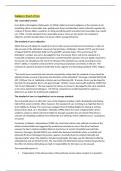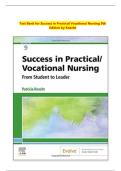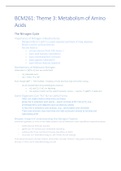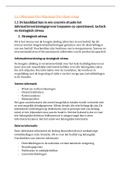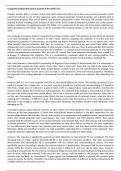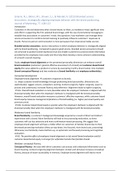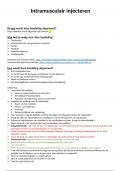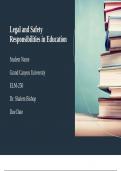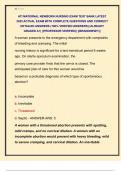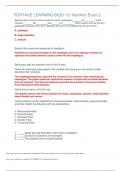Negligence: Breach of Duty
The ‘reasonable’ person:
From Blyth v Birmingham Waterworks Co (1856), Alderson B said ‘negligence is the omission to do
something which a reasonable man, guided upon those considerations which ordinarily regulate the
conduct of human affairs, would do, or doing something which a prudent and reasonable man would
not.’ [784]. For the standard of the reasonable person, there are two points: the standard is
objective, and the standard does not always reflect average behaviour.
The standard of care is objective:
Whilst the law will adapt the standard of care to take account of external circumstances, it will not
take account of the defendant’s personal characteristics. Nettleship v Weston [1971] saw the Court
of Appeal hold the defendant liable for the plaintiff’s personal injury. This was because the
defendant’s conduct was not to be judged for that of a learner driver, but by the standard of a
reasonably competent and experienced one. Lord Denning MR said since she was legally required to
be insured, she should bear the risk of her driving. If the standard was varied according to every
driver’s ability, it would be costly and time-consuming and produce uncertainty in the law. ‘The
certainty of a general standard is preferable to the vagaries of a fluctuating standard’ [707], Megaw
LJ.
“The courts have consistently and correctly rejected the notion that the standard of care should be
adjusted to take account of personal characteristics of the defendant” (Dunnage v Randall [2016] QB
639, [130] per Vos LJ). Nettleship v Weston per Lord Denning MR: ‘A learner driver may be doing his
best but his incompetent best is not good enough.’ Wilsher v Essex Area Health Authority [1987] Q.B.
730, CA per Glidewell LJ: ‘The law requires the trainee or learner to be judged by the same standard
as his more experienced colleagues. If it did not, inexperience would frequently be urged as a
defence to an action for professional negligence.’
The standard of care is a hypothetical, not an average standard:
The reasonable person is often the ‘man on the Clapham omnibus’ (Hall v Brooklands Auto Racing
Club [1933], Green LJ [244]). Often, however, the standard of care in driving is so high that there is
strict liability for driving. The courts have stopped short of holding liability for driving is entirely
divorced from fault, as in Mansfield v Weetabix [1998] where the Court of Appeal held a driver
unable to control a vehicle will not be liable for damage caused by loss of control if the driver is
unaware of a disabling condition from which they are suffering, which suddenly occurs, causing loss
of control.
Previously, in Roberts v Ramsbottom [1980], the Court held a driver who suffered as stroke at the
wheel remained liable and suggested he would have remained so even if the driver had been
unaware he had a medical condition likely to lead to loss of control. Mansfield overruled this,
however. Dunnage v Randall [2015] saw a distinction between Mansfield, where a mentally and
physically fit driver had begun his journey, against a mentally ill person acting irrationally and
injuring another where the objective standard would apply. Dunnage saw the defendant suffering
schizophrenia and set himself on fire. The court held only defendants whose medical incapacity has
the effect of entirely eliminating any fault or responsibility for the injury can be excused.
The reasonable person is:
‘Independent of the idiosyncrasies of the particular person whose conduct is in question.’
, Not ‘unduly timorous’ nor overly fearless.
‘free both from over-apprehension and over-confidence’
‘It is left to the judge to decide what, in the circumstances of the particular case, the reasonable man
would have had in contemplation and what accordingly the party sought to be made liable ought to
have foreseen’ (Glasgow Corporation v Muir [1943] AC 448, 457 per Lord Macmillan)
Special Standards of Care:
Children:
There is no defence of ‘childhood’: Gorely v Codd [1967] 1 WLR 19 – unlike the criminal law. Not the
standard of the ordinary prudent and reasonable adult instead, the standard of the ordinary prudent
and reasonable child of the same age as the defendant. Closer child gets to adulthood, closer
standard gets to adult standard. McHale v Watson (1966) 115 CLR 199, “The standard of care being
objective, it is no answer for [a child,] any more than it is for an adult, to say that the harm he caused
was due to his being abnormally slow-witted, quick-tempered, absent-minded or inexperienced. But
it does not follow that he cannot rely in his defence upon a limitation upon the capacity for foresight
or prudence, not as being personal to himself, but as being characteristic of humanity at his stage of
development and in that sense normal. By doing so he appeals to a standard of ordinariness, to an
objective and not a subjective standard.” Gough v Thorne [1966] 1 W.L.R. 1387. “The question as to
whether the plaintiff can be said to have been guilty of contributory negligence depends on whether
any ordinary child of 13½ could be expected to have done any more than this child did. I say,
“ordinary child.” I do not mean a paragon of prudence; nor do I mean a scatterbrained child; but the
ordinary girl of 13½.” (1391 per Salmon LJ).
Mullin v Richards [1998] 1 W.L.R. 1304, “The question for the judge is not whether the actions of the
defendant were such as an ordinarily prudent and reasonable adult in the defendant's situation
would have realised gave rise to a risk of injury, it is whether an ordinarily prudent and reasonable
15-year-old schoolgirl in the defendant's situation would have realised as much” (1308 per
Hutchison LJ), “girls of 15 playing together may play as somewhat irresponsible girls of 15” (1312 per
Butler-Sloss LJ). Standard expected increases with age
Children and Adult Activities
If a child is driving (on the public road) should the standard of care be
The standard expected of a reasonable child of their age; or
The standard expected of a experienced, skilled and careful driver (Nettleship)?
No English authority on the point. McErlean v Sarel 61 OR (2d) 396; 42 DLR (4th) 577, "Where a child
engages in what may be classified as an "adult activity'', he or she will not be accorded special
treatment, and no allowance will be made for his or her immaturity. In those circumstances, the
minor will be held to the same standard of care as an adult engaged in the same activity." Dellwo v
Pearson 259 Minn. 452, 107 N.W. 2d 859 (1961), “While minors are entitled to be judged by
standards commensurate with age, experience, and wisdom when engaged in activities appropriate
to their age, experience, and wisdom, it would be unfair to the public to permit a minor in the
operation of a motor vehicle to observe any other standards of care and conduct than those
expected of all others. A person observing children at play with toys, throwing balls, operating
tricycles or velocipedes, or engaged in other childhood activities may anticipate conduct that does
not reach an adult standard of care or prudence. However, one cannot know whether the operator
of an approaching automobile, airplane, or powerboat is a minor or an adult, and usually cannot
The ‘reasonable’ person:
From Blyth v Birmingham Waterworks Co (1856), Alderson B said ‘negligence is the omission to do
something which a reasonable man, guided upon those considerations which ordinarily regulate the
conduct of human affairs, would do, or doing something which a prudent and reasonable man would
not.’ [784]. For the standard of the reasonable person, there are two points: the standard is
objective, and the standard does not always reflect average behaviour.
The standard of care is objective:
Whilst the law will adapt the standard of care to take account of external circumstances, it will not
take account of the defendant’s personal characteristics. Nettleship v Weston [1971] saw the Court
of Appeal hold the defendant liable for the plaintiff’s personal injury. This was because the
defendant’s conduct was not to be judged for that of a learner driver, but by the standard of a
reasonably competent and experienced one. Lord Denning MR said since she was legally required to
be insured, she should bear the risk of her driving. If the standard was varied according to every
driver’s ability, it would be costly and time-consuming and produce uncertainty in the law. ‘The
certainty of a general standard is preferable to the vagaries of a fluctuating standard’ [707], Megaw
LJ.
“The courts have consistently and correctly rejected the notion that the standard of care should be
adjusted to take account of personal characteristics of the defendant” (Dunnage v Randall [2016] QB
639, [130] per Vos LJ). Nettleship v Weston per Lord Denning MR: ‘A learner driver may be doing his
best but his incompetent best is not good enough.’ Wilsher v Essex Area Health Authority [1987] Q.B.
730, CA per Glidewell LJ: ‘The law requires the trainee or learner to be judged by the same standard
as his more experienced colleagues. If it did not, inexperience would frequently be urged as a
defence to an action for professional negligence.’
The standard of care is a hypothetical, not an average standard:
The reasonable person is often the ‘man on the Clapham omnibus’ (Hall v Brooklands Auto Racing
Club [1933], Green LJ [244]). Often, however, the standard of care in driving is so high that there is
strict liability for driving. The courts have stopped short of holding liability for driving is entirely
divorced from fault, as in Mansfield v Weetabix [1998] where the Court of Appeal held a driver
unable to control a vehicle will not be liable for damage caused by loss of control if the driver is
unaware of a disabling condition from which they are suffering, which suddenly occurs, causing loss
of control.
Previously, in Roberts v Ramsbottom [1980], the Court held a driver who suffered as stroke at the
wheel remained liable and suggested he would have remained so even if the driver had been
unaware he had a medical condition likely to lead to loss of control. Mansfield overruled this,
however. Dunnage v Randall [2015] saw a distinction between Mansfield, where a mentally and
physically fit driver had begun his journey, against a mentally ill person acting irrationally and
injuring another where the objective standard would apply. Dunnage saw the defendant suffering
schizophrenia and set himself on fire. The court held only defendants whose medical incapacity has
the effect of entirely eliminating any fault or responsibility for the injury can be excused.
The reasonable person is:
‘Independent of the idiosyncrasies of the particular person whose conduct is in question.’
, Not ‘unduly timorous’ nor overly fearless.
‘free both from over-apprehension and over-confidence’
‘It is left to the judge to decide what, in the circumstances of the particular case, the reasonable man
would have had in contemplation and what accordingly the party sought to be made liable ought to
have foreseen’ (Glasgow Corporation v Muir [1943] AC 448, 457 per Lord Macmillan)
Special Standards of Care:
Children:
There is no defence of ‘childhood’: Gorely v Codd [1967] 1 WLR 19 – unlike the criminal law. Not the
standard of the ordinary prudent and reasonable adult instead, the standard of the ordinary prudent
and reasonable child of the same age as the defendant. Closer child gets to adulthood, closer
standard gets to adult standard. McHale v Watson (1966) 115 CLR 199, “The standard of care being
objective, it is no answer for [a child,] any more than it is for an adult, to say that the harm he caused
was due to his being abnormally slow-witted, quick-tempered, absent-minded or inexperienced. But
it does not follow that he cannot rely in his defence upon a limitation upon the capacity for foresight
or prudence, not as being personal to himself, but as being characteristic of humanity at his stage of
development and in that sense normal. By doing so he appeals to a standard of ordinariness, to an
objective and not a subjective standard.” Gough v Thorne [1966] 1 W.L.R. 1387. “The question as to
whether the plaintiff can be said to have been guilty of contributory negligence depends on whether
any ordinary child of 13½ could be expected to have done any more than this child did. I say,
“ordinary child.” I do not mean a paragon of prudence; nor do I mean a scatterbrained child; but the
ordinary girl of 13½.” (1391 per Salmon LJ).
Mullin v Richards [1998] 1 W.L.R. 1304, “The question for the judge is not whether the actions of the
defendant were such as an ordinarily prudent and reasonable adult in the defendant's situation
would have realised gave rise to a risk of injury, it is whether an ordinarily prudent and reasonable
15-year-old schoolgirl in the defendant's situation would have realised as much” (1308 per
Hutchison LJ), “girls of 15 playing together may play as somewhat irresponsible girls of 15” (1312 per
Butler-Sloss LJ). Standard expected increases with age
Children and Adult Activities
If a child is driving (on the public road) should the standard of care be
The standard expected of a reasonable child of their age; or
The standard expected of a experienced, skilled and careful driver (Nettleship)?
No English authority on the point. McErlean v Sarel 61 OR (2d) 396; 42 DLR (4th) 577, "Where a child
engages in what may be classified as an "adult activity'', he or she will not be accorded special
treatment, and no allowance will be made for his or her immaturity. In those circumstances, the
minor will be held to the same standard of care as an adult engaged in the same activity." Dellwo v
Pearson 259 Minn. 452, 107 N.W. 2d 859 (1961), “While minors are entitled to be judged by
standards commensurate with age, experience, and wisdom when engaged in activities appropriate
to their age, experience, and wisdom, it would be unfair to the public to permit a minor in the
operation of a motor vehicle to observe any other standards of care and conduct than those
expected of all others. A person observing children at play with toys, throwing balls, operating
tricycles or velocipedes, or engaged in other childhood activities may anticipate conduct that does
not reach an adult standard of care or prudence. However, one cannot know whether the operator
of an approaching automobile, airplane, or powerboat is a minor or an adult, and usually cannot

